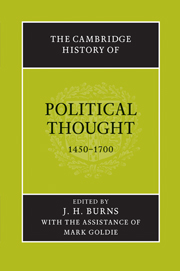Book contents
- Frontmatter
- Introduction
- I Renaissance and Counter-Renaissance
- II Religion, civil government, and the debate on constitutions
- 6 Christian obedience and authority, 1520–1550
- 7 Calvinism and resistance theory, 1550–1580
- 8 Catholic resistance theory, Ultramontanism, and the royalist response, 1580—1620
- 9 Constitutionalism
- 10 Sovereignty and the mixed constitution: Bodin and his critics
- 11 Utopianism
- III Absolutism and Revolution in the Seventeenth Century
- IV The end of Aristotelianism
- V Natural law and utility
- Conclusion
- Biographies
- Bibliography
- Index of names of persons
- Index of subjects
- References
8 - Catholic resistance theory, Ultramontanism, and the royalist response, 1580—1620
from II - Religion, civil government, and the debate on constitutions
Published online by Cambridge University Press: 28 March 2008
- Frontmatter
- Introduction
- I Renaissance and Counter-Renaissance
- II Religion, civil government, and the debate on constitutions
- 6 Christian obedience and authority, 1520–1550
- 7 Calvinism and resistance theory, 1550–1580
- 8 Catholic resistance theory, Ultramontanism, and the royalist response, 1580—1620
- 9 Constitutionalism
- 10 Sovereignty and the mixed constitution: Bodin and his critics
- 11 Utopianism
- III Absolutism and Revolution in the Seventeenth Century
- IV The end of Aristotelianism
- V Natural law and utility
- Conclusion
- Biographies
- Bibliography
- Index of names of persons
- Index of subjects
- References
Summary
Patterns of controversy
The preceding chapter has outlined the development of Huguenot doctrines of resistance during the first half of the French religious wars. It was one of the ironies of the time that, in the second half, some French Protestant writers turned to support royal authority while their most bitter enemies among Catholic enthusiasts occupied the vacant ground with Catholic theories of resistance. The Holy League, in which these doctrines were evolved, relied not only upon secular justification of armed opposition but also upon the power of the papacy to depose temporal sovereigns and authorise armed opposition for religious reasons. In response, royalist theory was associated with the tradition of independence within the Gallican church. In England at the same time the Anglican settlement was defended against Puritan pressure for further reform and a Catholic campaign for reconversion that in one aspect was peaceful and non-political and in another welcomed papal deposition and foreign invasion. Not surprisingly, English and French royalism had much in common, however different the institutions and traditions of the two countries. In the early seventeenth century a European debate took place over the respective powers of kings and popes which invoked and redefined ideas generated by the French Holy League.
The three principal strands in secular Huguenot resistance theory were also contained in the ideas of the League. There were: loyal resistance to malevolent and Machiavellian advisers who had usurped royal authority; constitutional opposition to a king who had overstepped limitations defined by law and history; and communal defiance of a tyrant in the name of the ultimate power, or ‘popular sovereignty’, of the commonwealth over the ruler.
- Type
- Chapter
- Information
- The Cambridge History of Political Thought 1450–1700 , pp. 219 - 253Publisher: Cambridge University PressPrint publication year: 1991
References
- 15
- Cited by

